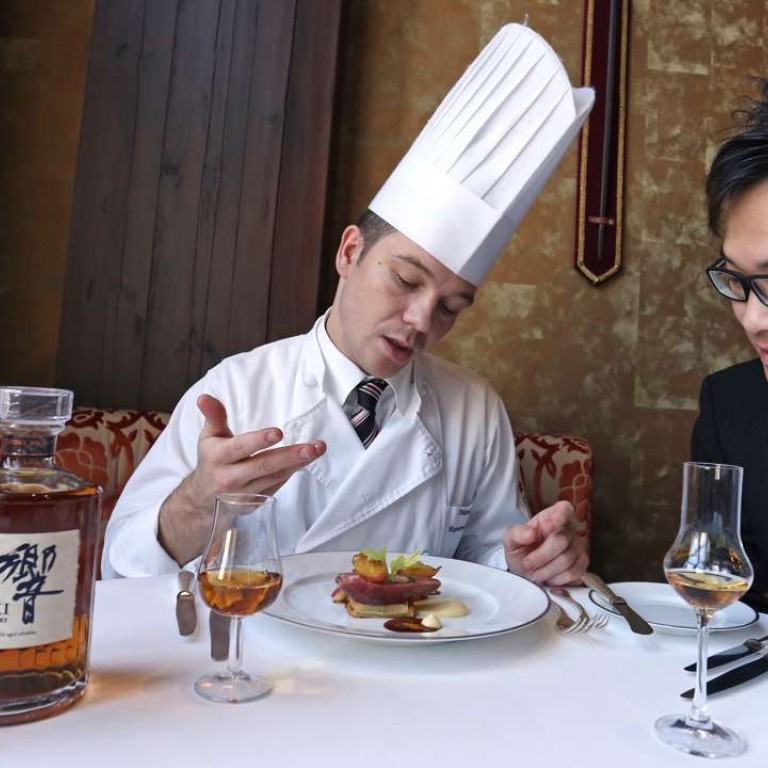
Why Hong Kong restaurants are pairing whisky, not just wine, with food
The spirit has often been drunk with starters and desserts, but it works well with a surprising range of dishes, from the humble corn dog to yakitori and Cantonese dishes including sea cucumber
It used to be that fine-dining restaurants would promote tasting menus that were paired with expensive wines, but increasingly it’s whisky that is the beverage of choice. The drink was considered by many to be too strong to partner with food,but recent events show there is plenty of interest.
The recent Hong Kong Whisky Festival 2016 at the InterContinental Grand Stanford, and the Malt Masters festival at the Conrad, both offered popular pairing seminars.

“Some chemical reactions can build a bridge between the spirit and the food. Take the Maillard reaction for example. That is the chemical reaction between amino acids and reducing sugars (browning) when food reaches a certain temperature. It creates a lot of flavours – in roasted coffee, chocolate, grilled steaks, and anything barbecued,” he says. “That also takes place in the whisky making processes of malting barley and charring casks [in which whisky is matured and from which it takes much of its flavour]. We can recognise flavours that pair across.”
In the course of his seminars Henderson paired Japanese whiskies with yakitori (grilled chicken skewers); American whiskey with a maple corn dog (whiskey and maple syrup, he says, often go well together); and Irish whiskey with crab and ginger salad on boxty (a potato pancake).
The Scottish island whiskies, he says, often have an affinity with seafood, particularly oysters and smoked salmon.
Bruges agrees with Henderson that whisky can be a good partner to grilled meats.
“My personal preference is for sherry oak-aged whiskies, as I feel they have a smoother taste, with citrus notes and hints of dried fruits such as raisins, prunes, figs, apricots and dates, and spices such as cinnamon and star anise. These flavours complement the richness and fattiness of well-marbled beef, such as US prime, and our bone marrow dish, while the citrus notes help to cleanse the palate and make each bite feel like it is the first one – another reason why I created a whisky fig jam to pair with the latter. For charcuterie, the sherry oak works very well because of the wood smoke and spice flavours that come through.”

Most whisky promotions in restaurants take the form of one-off dinners with guest speakers (sometimes wearing kilts, sometimes not). Some restaurants offer whisky pairing menus over a longer stretch.


“When pairing with whisky you need strong meaty flavours to achieve a harmony with the strong flavour of the spirit,” he says. “I recommend drinking it neat or with just one or two pieces of ice, otherwise you lose the authentic taste.”
I tried a few selections with wine and spirits consultant Ron Taylor, and we agreed that while the Glen Garioch was a superb textural match with the sauce for the sea cucumber, the Bowmore was a better match for the marine flavours of the dish.
The concept of pairing is essentially the same as for wine. If you have a rich, full-bodied whisky you go with heavier food; if you have a less full-bodied whisky you go for lighter flavours
The beef tasted best anointed with a few drops of the Bowmore, rather than preceded or followed by a sip – a trick Taylor says he learned from a sake master who did something similar with sake and steak.
On April 14 Taylor will be the guest speaker at a Macallan whisky pairing dinner at Hugo’s at which a range of different expressions of the whisky will be served, including the limited edition The Macallan M – of which only 10 bottles were made available to Hong Kong. The dinner is priced at HK$3,268 per person.
Taylor and I share the view that most of the best whisky and food matches are at the beginning and end of a meal, starting with oysters or other seafood appetisers, then with desserts – particularly those with chocolate in them.
The Macallan M, paired with whisky chocolate fondant with orange and praline chiboust, ought to be a treat.
Single-minded Macallan fans will probably pack that dinner out, but for whisky lovers with wider- ranging tastes, the regular four-course East Meets West pairing dinner is priced at HK$1,750 per head and includes one whisky of your choice with each of the first three courses.

Two of the whiskies are “sommelier’s picks”, and Au rates the intense 17-year-old Hibiki blended whisky as a match for poached or smoked seafood, and dressings with orange and honey. For grilled or roasted red meat in a spicy or creamy sauce his choice is the 30-year-old Strathisla single malt.
“The concept of pairing is essentially the same as for wine. If you have a rich, full-bodied whisky you go with heavier food; if you have a less full-bodied whisky you go for lighter flavours,” says Mehr. “Do not overwhelm the flavour of the whisky, or of the food. You look for a balance.”
Mehr and Au find that the best whisky and food matches have a smoky element and an oily texture in common.
“For main courses the main problem is getting the oiliness without too much fat, because whisky does not cut through it in the same way as wine. It’s harder to get the right feeling in the mouth; there are fewer whiskies than wines to choose from. In that sense it’s simpler,” Au concludes.

